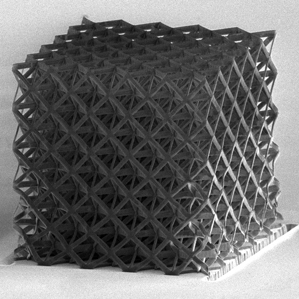technologyreview | A new type of material, made up of nanoscale struts crisscrossed like
the struts of a tiny Eiffel Tower, is one of the strongest and lightest
substances ever made.
If researchers can figure out how to make
the stuff in large quantities, it could be used as a structural material
for making planes and trucks, as well as in battery electrodes.
Researchers led by Caltech materials scientist Julia Greer
found that by carefully designing nanoscale struts and joints, they
could make ceramics, metals, and other materials that can recover after
being crushed, like a sponge. The materials are very strong and light
enough to float through the air like a feather. The work is published
today in the journal Science.
In
conventional materials, strength, weight, and density are correlated.
Ceramics, for example, are strong but also heavy, so they can’t be used
as structural materials where weight is critical—for example, in the
bodies of cars. And when ceramics fail, they tend to fail
catastrophically, shattering like glass.
But at the nanoscale the
same rules do not apply. In this size range, the structural and
mechanical properties of ceramics become less tied to properties such as
weight, and they can be altered more precisely.
“For ceramics, smaller is tougher,” says Greer, who was named one of MIT Technology Review’s 35 Innovators Under 35 in 2008
for her work on nanoscale mechanics. This means that nanoscale trusses
made from ceramic materials can be both very light—unsurprising, since
they are mostly air—and extremely strong.



0 comments:
Post a Comment